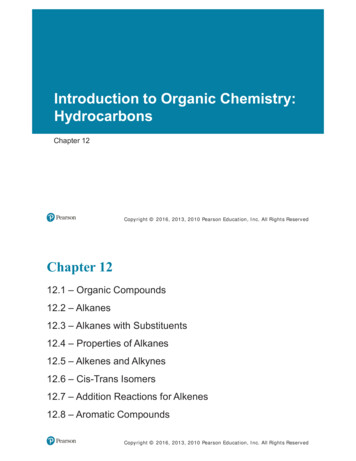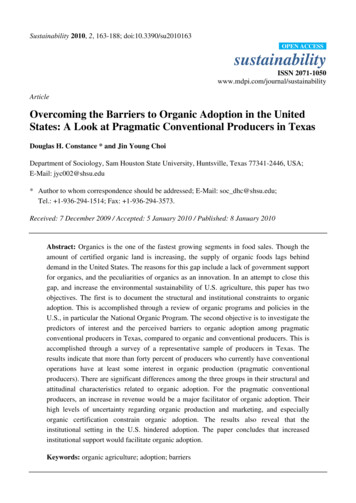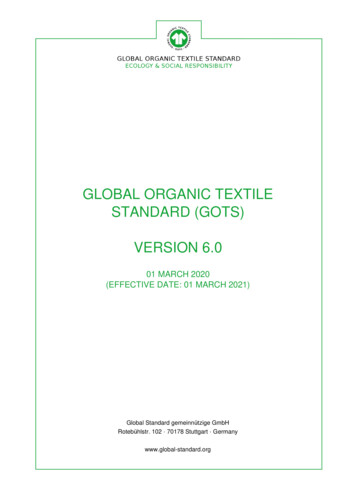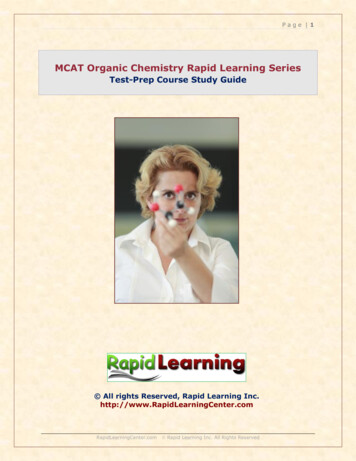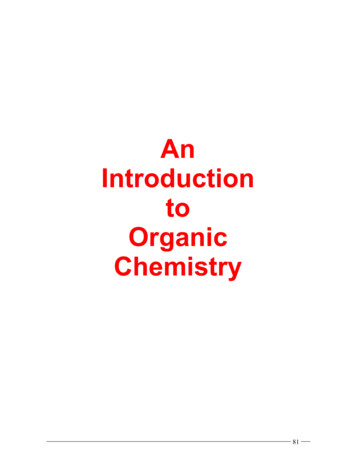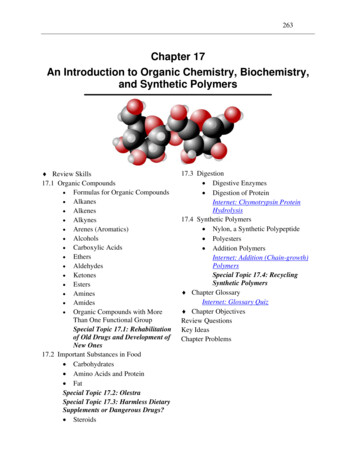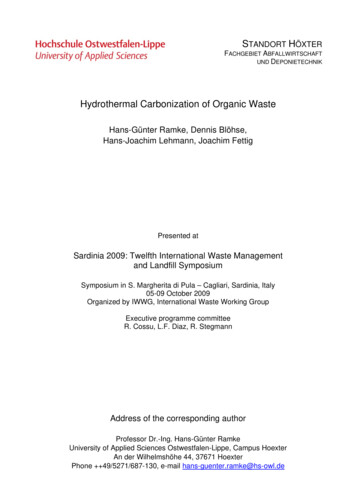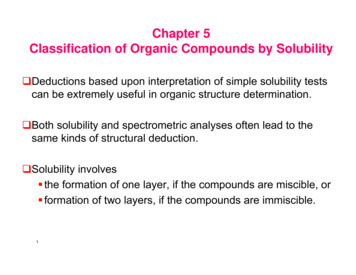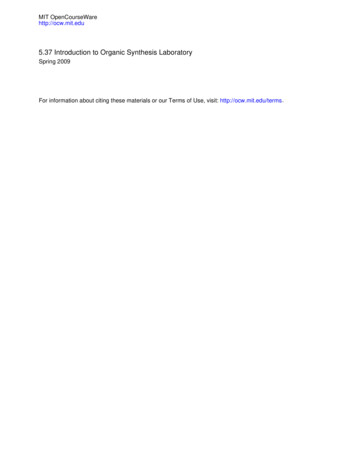
Transcription
MIT OpenCourseWarehttp://ocw.mit.edu5.37 Introduction to Organic Synthesis LaboratorySpring 2009For information about citing these materials or our Terms of Use, visit: http://ocw.mit.edu/terms.
Chemistry 5.37URIECA Module 7: Introduction to Organic SynthesisDays 1-4 Monoesterification of Dibenzyl Tartrate with2,6-Dimethoxybenzoyl ChlorideOOOCH2PhClOOCH2PhOPhCH2OOMeOHOHOMeOEt3N, cat. DMAPCH2Cl2, refluxPhCH2OOOHOOMeMeODay 1: Purification of Reactants for the Esterification ReactionDigital Techniques Manual: TLC-The Basics and TLC-Advanced, Distillation I,Recrystallization, Filtration, Melting Point DeterminationMohrig, Hammond, & Schatz: Chapter 6 (Heating and Cooling Methods), Chapter 11(Boiling Points and Distillation), Chapter 15 (Thin-Layer Chromatography), Chapter 5(Measuring Mass and Volume), Chapter 9 (Recrystallization), and Chapter 10 (Melting Pointsand Melting Ranges).Equipment:Glass-backed silica TLC plates, glass capillary TLC spotters, three TLCchambers with filter paper, TLC developing stock solutions (ceric ammoniummolybdenate, phosphomolybdic acid, and p-anisaldehyde), small vials, disposableglass pipettes and pipette bulbs. For distillation: short path distillation head,distillation cow, three 10-mL round-bottomed flasks, 25-mL round-bottomedflask, glass stoppers. For trituration: 250-mL Erlenmeyer flask, spatula, glassrod, Buchner funnel, 500-mL Erlenmeyer filter flask, 100-mL graduated cylinder.For recrystallization: 250-mL Erlenmeyer flask, 50-mL round bottomed flask,500-mL beaker, vials, filter funnel. Chemicals: diethyl ether, ethyl acetate,hexanes, triethylamine, and calcium hydride.For optimal results it is necessary to purify the triethylamine that is used as an HCl scavenger in theesterification reaction. In particular, if any water is present in the triethylamine, then it canhydrolyze the acyl chloride faster than your alcohol reacts, and thus reduce the yield of the desiredester product. Triethylamine can be dried by stirring it over calcium hydride and then distilling itinto a dry flask at atmospheric pressure under nitrogen.Transfer 10-15 mL of triethylamine into a 25-mL round-bottomed flask by dispo pipette. Add amagnetic stirbar and ca. 0.5 g of calcium hydride. Attach a short-path distillation head equippedwith a thermometer to the distillation flask and equip the still head with an oven-dried cow attachedto your nitrogen line via a T connector. Be sure to connect the condenser of the still head to yourwater line. The third branch of the T connector should be linked to an oil bubbler via Tygon tubing.8
Chemistry 5.37URIECA Module 7: Introduction to Organic SynthesisThe cow should be equipped with three oven-dried, 10-mL, round-bottomed flasks. Stir thetriethylamine over calcium hydride for at least 1.5 h. Distill the triethylamine at atmosphericpressure by heating the flask in a sand bath; the boiling point of triethylamine is 89 C. Collect atleast 5 mL of dry triethylamine. Seal the flask containing the distilled triethylamine with a glassstopper. Any other triethylamine that you distill over can be returned to the original bottle. Thecalcium hydride remaining in the distillation flask should be quenched according to the proceduredescribed in Part VI.Photo of distillation setup hereThe following purification of dibenzyl tartrate should be started while the triethylamine is stirringover calcium hydride. The sample of dibenzyl tartrate you will be given is the crude product from areaction of benzyl alcohol and tartaric acid that was run by the teaching assistants. The sample ofdiester is impure and contains a small amount of unreacted benzyl alcohol. Separation of the benzylalcohol impurity from the diester by chromatography would be difficult, and can be accomplishedmore easily on a large scale by trituration followed by recrystallization according to the proceduredescribed below.First, check the purity of your sample of dibenzyl tartrate by TLC analysis on silica gel using thetechniques introduced in Module 6. A sample of benzyl alcohol can be obtained for reference fromyour teaching assistant. For eluant, begin by trying 25% ethyl acetate-hexane, but you may wish toexamine other solvent systems. Visualization should be carried out by UV and PMA.The first step in the purification of the crude dibenzyl tartrate is trituration. Trituration is the processin which a solid is treated with a solvent in which it is not soluble but which does dissolve some ofthe impurities present. You will be given ca. 10 g of crude dibenzyl tartrate in a 250-mL Erlenmeyerflask. Trituration of your dibenzyl tartrate (the crude material is a gummy solid) is carried out byadding 200 mL of hexane and 10 mL of diethyl ether to the diester in the 250-mL Erlenmeyer. Ruband grind the solid material with a glass rod and metal spatula for 5-10 min to break up clumps andto thoroughly mix the solid with the solvent. Next, add a magnetic stirbar to the flask and stir themixture for 10 min. Filter the resulting mixture through a filter paper disk on a Buchner funnel intoa 500-mL Erlenmeyer filter flask, washing the solid that you collect with three 15-mL portions of9
Chemistry 5.37URIECA Module 7: Introduction to Organic Synthesis20:1 hexane-ether. Transfer the solid to a tared 250-mL Erlenmeyer flask and record the weight ofdibenzyl tartrate (you should have at least 9 g at this stage of the purification).Recrystallize your dibenzyl tartrate from a mixture of hexane and ethyl acetate according to thefollowing procedure. First, add the minimum amount of ethyl acetate to the solid required todissolve it. Add ethyl acetate in small portions and thoroughly stir the mixture before adding thenext portion. A total of approximately 30 mL of ethyl acetate will be needed. Next, add hexane insmall portions (ca. 5-10 mL at a time) until the solution just begins to become cloudy.Approximately 50 mL of hexane will be required. Finally, add ethyl acetate again dropwise until themixture just again becomes clear. At this point, cool the Erlenmeyer flask in an ice-water bath.Dibenzyl tartrate will crystallize and cooling should be continued until no further solid appears (ca.20 min). Collect the solid by filtration through a filter paper disk on a Buchner funnel into a 500-mLErlenmeyer filter flask, washing the solid that you collect with three 10-mL portions of cold hexane.Transfer the solid to a tared 500-mL beaker and record the weight of pure dibenzyl tartrate (youshould have 8-9 g). Carry out TLC analysis of the product to confirm that no benzyl alcohol ispresent. Next, dry the solid by spreading it out on the bottom of the beaker, covering the top of thebeaker with a Kimwipe secured with a rubber band (to keep out dust), and allowing it to standexposed to air until your next laboratory period.Day 2: Setting Up the Esterification ReactionDigital Techniques Manual: Refluxing a ReactionMohrig, Hammond, & Schatz: Chapter 5 (Measuring Mass and Volume), and Chapter 7(Assembly of Reaction Apparatus and Planning a Chemical Reaction)Equipment: Disposable glass pipettes and pipette bulbs, sand bath, 250-mL three-neckedround-bottomed flask, reflux condenser, three-way stopcock with inlet adapter,magnetic stirbar, oil bubbler, 2 glass stoppers, 100-mL graduated cylinder, 5-mLsyringe, heating mantle, dichloromethane, 4-dimethylaminopyridine.Measure the melting point of your dried dibenzyl tartrate (the mp of pure diester is 49-50 C). Youwill need 6.1 g for the esterification reaction that you will set up on this day of Module 7.The esterification will be carried out in an oven-dried, 250-mL, three-necked, round-bottomed flaskequipped with a magnetic stirbar. The center neck of the flask should be fitted with a refluxcondenser topped with a inlet adapter connected to a three-way stopcock. One branch of thestopcock is connected by tygon tubing to the nitrogen source, and the other branch to an oil bubblerto allow for the monitoring of the nitrogen flow rate. The two side necks of the reaction flask arecapped with glass stoppers. A photograph of the reaction setup is shown in Figure 1 below.10
Chemistry 5.37URIECA Module 7: Introduction to Organic SynthesisFigure 1. Reaction setup forthe esterification reaction.Remove the flask from the oven and quickly assemble it and begin the flow of nitrogen while it isstill hot. The reaction flask is flushed with nitrogen for 5 min by turning the three-way stopcock soas to temporarily cut off flow to the bubbler and to direct nitrogen into the flask while a glassstopper is removed from one of the side necks. With the flow of nitrogen continuing, the flask isthen charged via the open side neck with 6.1 g (18.5 mmol, 1.02 equiv) of dibenzyl tartrate (a solid)and then 100 mL of dichloromethane (previously dried over 4A molecular sieves) is added in oneportion. Triethylamine (4 mL, 28.8 mmol, 1.58 equiv), previously distilled from calcium hydride, isthen added with a 5 mL syringe followed by 4-dimethylaminopyridine (0.050 g, 0.4 mmol, 0.02equiv). 4-Dimethylaminopyridine is a solid with mp 112-114 C. The side neck is capped with aglass stopper, the three-way stopcock is adjusted so that it is open to the nitrogen source, flask, andthe bubbler, and the reaction mixture is cooled in an ice-water bath. Once the reaction mixture hasreached ca. 0 C, the first portion of 2,6-dimethoxybenzoyl chloride is added by momentarilyopening a side neck and adding the acyl chloride. Commerically available 2,6-dimethoxybenzoylchloride is only 80% pure, so a total of 4.65 g of this material must be used in order to have 18.2mmol (1.0 equiv) of acyl chloride. Note that 2,6-dimethoxybenzoyl chloride is a solid with mp 6466 C. The acyl chloride is added in five portions at ca. 10-min intervals. After the last portion isadded, the ice bath is replaced with a heating mantle and the reaction mixture is heated at a gentlereflux (the boiling point of dichloromethane is 40 C). Place a tag on your flask with your name andindicating the time that reflux was begun. A teaching assistant will shut off the heat 24 h after thetime you indicate on the tag and the reaction will be allowed to run at room temperature until yournext laboratory period.11
Chemistry 5.37URIECA Module 7: Introduction to Organic SynthesisDay 3: Workup of the Esterification ReactionDigital Techniques Manual: Reaction Workup I and IIMohrig, Hammond, & Schatz: Chapter 8 (Extraction and Drying Organic Liquids.Equipment: Disposable glass pipettes and pipette bulbs, 100-mL graduated cylinder, 500-mLseparatory funnel, 1-L Erlenmeyer, two 500-mL Erlenmeyers, 250-mL roundbottomed flask, 50-mL round-bottomed flask, filter funnel, fluted filter paper,dichloromethane, saturated sodium bicarbonate solution, saturated NaClsolution, anhydrous sodium sulfate.Confirm that the esterification reaction is complete by performing TLC analysis on a sample of thereaction mixture withdrawn from the flask through a side neck with your TLC spotter. If TLCindicates that substantial starting material remains, consult with your teaching assistant.The workup outlined below is designed to remove any carboxylic acid impurities; the excesstriethylamine (bp 89 C) will be removed after the workup by rotary evaporation. First, transfer thereaction mixture to a 500-mL separatory funnel, rinsing the flask with a small amount ofdichloromethane and water to ensure complete transfer of the contents of the flask. Extract theorganic solution with 100 mL of water, and then back-extract the aqueous phase with 50 mL ofdichloromethane. Extract the combined organic phases with three 75-mL portions of saturatedsodium bicarbonate solution and then 75 mL of water. Transfer the organic solution to a 500-mLErlenmeyer flask and dry it over anhydrous sodium sulfate. Filter the solution into a 250-mL roundbottomed flask and concentrate it by rotary evaporation at ca. 20 Torr and 40 C to remove thedichloromethane and triethylamine. Transfer the product to a tared 50-mL round-bottomed flaskusing a small amount of dichloromethane and again concentrate the solution. Record the weight ofyour “crude product” and check it by TLC analysis using 3:1:5 hexane-diethyl etherdichloromethane as eluant. You should obtain ca. 9 g of crude esterification product as a gold orbrown-colored viscous liquid.Day 4: Purification of the Esterification ProductDigital Techniques Manual: Column ChromatographyMohrig, Hammond, & Schatz: Chapter 17 (Liquid Chromatography) and Chapter 19 pp 269276 (NMR Instrumentation and Sample Preparation)Equipment: Chromatography column (67 cm length, 55 mm width) with adapter and tubingfor top of column for applying pressure, funnel, 100-mL graduated cylinder, 230400 mesh silica gel 60, sand, 18 x 150-mm test tubes, test tube racks, roundbottomed flasks (50 and 500 mL), 1-L beaker, NMR tube, hexanes, diethyl ether,dichloromethane, and CDCl3.Purify your crude esterification product by flash column chromatography on 200 g of silica gel.Weigh out the silica gel in a 1-L beaker (200 g will come to about the 450-mL mark). Prepare the12
Chemistry 5.37URIECA Module 7: Introduction to Organic Synthesiscolumn using a 3:1:5 mixture of hexanes-diethyl ether-dichloromethane and then elute with the samesolvent system. For general guidance, refer to the Digital Techniques Manual, Chapter 17 of Mohriget al., and your experience with column chromatography from Module 6. Be sure to save a smallsample of the crude reaction product to use as a TLC reference sample; this should be spotted in lane1 on each plate as you monitor the fractions obtained in your chromatography. Collect 20-mLfractions in test tubes and identify the fractions containing your esterification product by TLCanalysis (remember that it is usually not necessary to perform TLC analysis of every fraction).Combine the desired fractions in a 500-mL round-bottomed flask and concentrate by rotaryevaporation to remove all of the solvent. Transfer the product to a tared 50-mL round-bottomedflask using dichloromethane and again remove all of the solvent by rotary evaporation. Record theweight of your purified esterification product and record the results of all TLC analyses and thedetails of your chromatographic purification following the same guidelines described in Module 6.The Organic Syntheses procedure reports obtaining 7.1-7.5 g (78-82% yield) of esterificationproduct; you will need at least 3 g to go on to the next step in the synthesis. Be sure that yournotebook record of the chromatographic purification is detailed and complete. Record the amount ofsilica gel used, and for each fraction collected indicate the volume and the eluant. Draw TLC plates(using the format described in Module 6) showing all of the fractions that were monitored by TLCanalysis.Obtain a proton NMR spectrum of a small sample of your purified product in CDCl3. Note that ifsolvent (e.g., ether, hexanes, or dichloromethane) appears in your spectrum, you will have toconcentrate your product further by rotary evaporation, record the new (solvent-free) weight ofproduct, and run another NMR spectrum to confirm the purity of your material. If necessary, theNMR spectrum can be run on an “off-day” for your group or at the beginning of Day 5 of themodule. NMR data for dibenzyl mono(2,6-dimethoxybenzoyl)tartrate can be found in the OrganicSyntheses paper by Yamamoto et al.Submit a copy of the NMR spectrum to your TA who must approve it before you proceed to the nextphase of the experiment. Also report the weight of your purified product to your TA.13
Chemistry 5.37 URIECA Module 7: Introduction to Organic Synthesis 20:1 hexane-ether. Transfer the solid to a tared 250-mL Erlenmeyer flask and record the weight of dibenzyl tartrate (you should have at least 9 g at this stage of the purification). Recrystallize your dibenzyl tartrate from a mixture of hexane and ethyl acetate according to the
